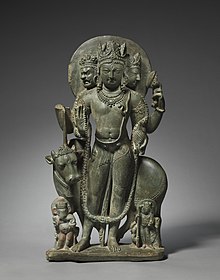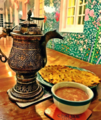Culture of Kashmir

The culture of Kashmir is part of Indian culture that encompasses the spoken language, written literature, cuisine, architecture, traditions, and history of the Kashmiri people native to the northern part of the Indian subcontinent. The culture of Kashmir was effected by the Persian as well as Central Asian cultures after the Islamic invasion of Kashmir. Kashmiri culture is heavily influenced by Hinduism, Buddhism and later by Islam.[1]
Early History[]

The Vedic art and culture grew in Kashmir, and some early Vedic hymns were composed in Kashmir.[2] The Bharata Natya Shastra is notable as an ancient encyclopedic treatise on the arts one which has influenced dance, music and literary traditions in Indian culture, originated in Kashmir.[3] Patanjali of 2nd century BC compiled his compendium on Yoga in Kashmir.[2] The Panchatantra is also said to be originated in Kashmir.[4] At the time when Pali was primary language for Buddhist literature in rest of India, all the Buddhist literature produced in Kashmir was in Sanskrit. Kashmiri women hold high status in society as Bilhana records that Kashmiri women were fluent both in Sanskrit and Pali.[citation needed] Kosh Shastra, a work on science of sex, second to Kamasutra was developed in Kashmir.[5] Some of the major texts that originated in Kashmir were Vigyan Bharaiv Tantra, Yoga Sutras, Sapndi Karkika,[6] Tantra Loka[7] Para-Trisika-Vivarana and many more.[8]
Cuisine[]
Rice is the staple food of Kashmiris and has been so since ancient times.[9] Meat, along with rice, is the most popular food item in Kashmir.[10] Kashmiris consume meat voraciously.[11] Despite being Brahmins, most Kashmiri Hindus are meat eaters.[12] Kashmiri beverages include Noon Chai or Sheer Chai and Kahwah or Kehew.
The Kashmir Valley is noted for its bakery tradition. Bakers sell various kinds of breads with golden brown crusts topped with sesame and poppy seeds. Tsot and tsochvor are small round breads topped with poppy and sesame seeds, which are crisp and flaky, sheermal, baqerkhayn (puff pastry), lavas (unleavened bread) and kulcha are also popular. Girdas and lavas are served with butter. Kashmiri bakerkhani has a special place in Kashmiri cuisine. It is similar to a round naan in appearance, but crisp and layered, and sprinkled with sesame seeds.[13] It is typically consumed hot during breakfast.[14]

Kashmiri Samovar and Noon Chai

Rogan Josh
Festivals[]
Kashmiri Hindus[]
Primary festivals of Kashmiri Hindus include:
- Herath (Shivaratri)
- Khetchmaavas
- Navreh
- Zyeth Atham
- Tiky Tsoram
- Pann
- Gaad Batt
Kashmiri Muslims[]
Primary festivals of Kashmiri Muslims include:
Language and literature[]
Kashmiri (English: /kæʃˈmɪəri/)[15] or Koshur (Kashmiri pronunciation: [/kəːʃur/]; كٲشُر,कॉशुर,






